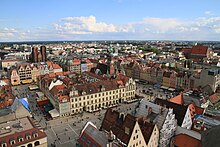Ring (market square)
In the German language, the Ring or Ringplatz is the name given to the central market square of a (medieval) city, particularly in Silesia , but more rarely in other regions such as Bohemia , Moravia or Transylvania . The ring is a special term, it is not synonymous with the word marketplace, which is used alongside for the remaining squares. The word ring was adopted in the Polish language as Rynek and there simply means market place.

In Silesia you can find them particularly often in the checkerboard-like old towns from the time of the German eastern settlement, in which they usually form the center. Usually these are roughly rectangular, but rarely symmetrical. The town hall is often on the edge of the ring or in the middle of the square , and in some cities there are even blocks of residential buildings in the middle of the square. This creates a square or polygonal "ring" between these and the development on the edge of the square in the cities, which are often laid out according to geometric development plans.
On the other hand, the term could not be derived from the square itself, but from the four streets that intersect at the square, frame it and thus form a ring. On the other hand, ring is also a name for a meeting place.
They were used for all important markets and festivals and for trade in general, including the Christmas markets, and thus formed the focus of everyday life in these planned cities. Today they are mostly the only traffic-free zones in cities.
selection
- Big ring in Wroclaw
- Ring (Gliwice) (Gleiwitz)
- Ring (Opole) (Opole)
- Main Market (Krakow)
- Old Town Square in Prague
literature
- Ring. In: Brockhaus' Kleines Konversations-Lexikon. Fifth edition, volume 2. Leipzig 1911, p. 537.
- Ring (4). In: Meyers Großes Konversations-Lexikon. Volume 16. Leipzig 1908, p. 945.
